The methodological dimension is a significant core of the Citizens’ Assemblies. In this section, analyses and other elements to deal with tools and methods which may serve Assemblies at any time are available. Such elements rely on methodological experience of the Alliance for a Responsible, Plural and United World. These will be gradually enhanced and enriched by the experiences achieved in the Citizens’ Assemblies.
Context
Mali’s Citizens’ Assembly is a process which aims at arousing a shared vision of the blockages that hinder the country’s evolution and at building perspectives of change. The process is based on a series of meetings which first began on the communal level. As a consequence of these first meeting, “a communal word” was elaborated by the participants by expressing society’s values, commitment values, challenges and proposals and strategies. The communal delegates later on met at a circle level (groupings of municipalities). During this meeting, a cross-sectional analysis of the communal words was carried out, and a circles’ proposal agenda was drafted.
The cartographic analysis meted was used so as to help build this communal word from the various contributions. It combines different operations: note-taking and debate systematization, use of Desmodo IT tool and cartography navigation, compilation of ideas and summary writing. Below is a description of the process implemented at three circles’ level: Tominian, Ségou and Niono, in Mali.
Cartography of the debates
- Stage 1: Debates and construction of a circle cartography
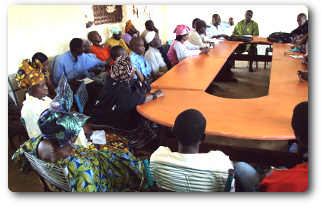
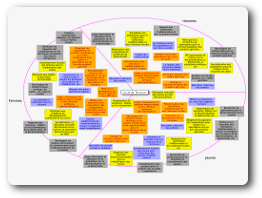
During the first stage, the main ideas arrived at during the debates of a circle are reported on a cartography (still called desmogram). Women’s statements are reported in the “women” section of the cartography. Men and Young people’s statements are distributed in two other fields. The title and the main aim of the cartography are located in the center. We, thus, obtain one cartography per circle. Each cartography represents a preliminary summary level of the debates on the circle level (click on the letter for actual size).
Color correspondence is specified on the second stage.
- Stage 2: Preliminary compilation of ideas
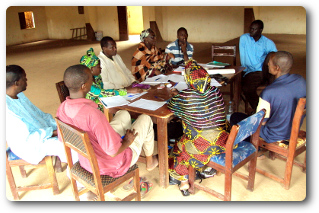
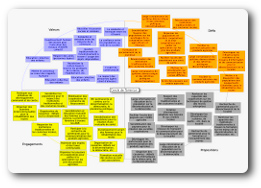
Desmodo [1] allows to easily build the cartographies, as well as to define the links and compilation categories between ideas. During this second stage, the statements are distributed within four expression dimensions per workshop: values, challenges, commitments and proposals (click on the letter for actual size). These are the same statements as those in the cartographies of the first stage, but they are organized differently now. Each category comprises contributions from young people, men and women.
Each dimension of the analysis is characterized by a color to enable easy reading of the cartography:
 Challenges,
Challenges,
 Values,
Values,
 Commitments,
Commitments,
 Proposals.
Proposals.
It is as if the idea was placed in a three-dimensional space formed by: circles, actors (youngsters, men and women) and categories (challenges, values, commitments, proposals).
- Stage 3: New systemic visualization of the contributions
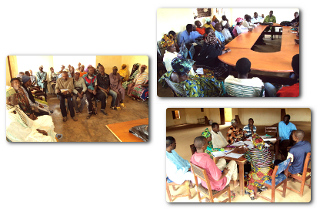

During this third stage, we have reversed the cartographies and placed in the center one actor and his or her contributions in the three circles of debates. This form of visualization allows for a new cross-sectional reading of the debates on the three circles level and for a more natural break-down of common elements (click on the letter for actual size).
- Stage 4: Summary writing from the cartographies
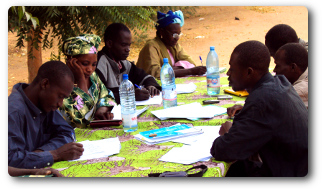

The construction of elements in common, the compilation of ideas and their interpretation depend mostly on the synthesis and demanding thinking process to be implemented. This can be carried out by human resources after – or even during - the debates, supported by the cartographies. In this case, it happened a posteriori.
The stage 2 report of Mali’s Citizens’ Assembly was constructed from the stages described above and from the progressive advance made through the cartographies.
Widening the method
This representation and cartographical analysis methodology is a significant move forward in order to tackle the information complexity of a debate and to make a democratic collective reflection. It should be highlighted that its implementation requires the negotiation of an organizationally and relationally complex supplementary level: in fact, this poses the question of the legitimacy of those who make the effort to summarize, of the cooperation levels and the levels of trust established between the work teams, and of the time that appropriating the method takes by the very participants and of the interaction with the IT tool. These aspects become essential to achieve the methodological effort. A process which manages to collectively add this sort of methodology is also a process that succeeds in sharing an innovative vision of collective intelligence and creating important degrees of cooperation and trust.